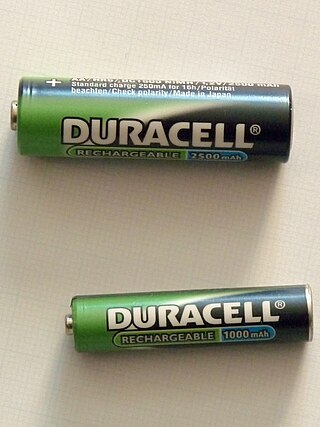Top Qs
Timeline
Chat
Perspective
Ampere-hour
Unit of electric charge From Wikipedia, the free encyclopedia
Remove ads
An ampere-hour or amp-hour (symbol: A⋅h or A h; often simplified as Ah) is a unit of electric charge, having dimensions of electric current multiplied by time, equal to the charge transferred by a steady current of one ampere flowing for one hour (3,600 seconds), thus equal to 3600 A⋅s or coulomb.[1][2]
The commonly seen milliampere-hour (symbol: mA⋅h, mA h, often simplified as mAh) is one-thousandth of an ampere-hour (3.6 coulombs).
Remove ads
Use
Summarize
Perspective
The ampere-hour is frequently used in measurements of electrochemical systems such as electroplating and for battery capacity where the commonly known nominal voltage is understood.
A milliampere second (mA⋅s) is a unit of measurement used in X-ray imaging, diagnostic imaging, and radiation therapy. It is equivalent to a millicoulomb. This quantity is proportional to the total X-ray energy produced by a given X-ray tube operated at a particular voltage.[3] The same total dose can be delivered in different time periods depending on the X-ray tube current.
To help express energy, computation over charge values in ampere-hour requires precise data of voltage: in a battery system, for example, accurate calculation of the energy delivered requires integration of the power delivered (product of instantaneous voltage and instantaneous current) over the discharge interval.[4] Generally, the battery voltage varies during discharge; an average value or nominal value may be used to approximate the integration of power.[5]
When comparing the energy capacities of battery-based products that might have different internal cell chemistries or cell configurations, a simple ampere-hour rating is often insufficient.
Remove ads
In other units of electric charge
One ampere-hour is equal to (up to 4 significant figures):
- 3600 coulombs
- 2.247 × 1022 elementary charges
- 0.03731 faradays
- 1.079 × 1013 statcoulombs (CGS-ESU equivalent)
- 360 abcoulombs (CGS-EMU equivalent)
Examples
- An AA size dry cell has a capacity of about 2000 to 3000 milliampere-hours.
- An average smartphone battery usually has between 2500 and 6000 milliampere-hours of rechargeable electric capacity.
- Automotive car starter batteries vary in capacity but a large automobile propelled by an internal combustion gasoline engine would have about a 50-ampere-hour 12 V battery capacity.
- Battery electric vehicle capacities are usually given in kW⋅h, but in 2013, the BMW i3 60 A⋅h was named after the capacity of one of its 96 cells, for a total of 96 × 3.6 V × 60 A⋅h = 20736 W⋅h with about 18 kW⋅h usable energy, to match the number of the entry level Tesla Model S60 which had 60 kW⋅h. Later BMW i3 had 94 A⋅h and 120 A⋅h batteries, each topping Tesla's S85, S90 and S100 designations.
- Since one ampere-hour can produce 0.336 grams of aluminium from molten aluminium chloride, producing a kilogram of aluminium required transfer of at least 2980 ampere-hours.[6] One kilogram of aluminium commonly requires 15.37 kW⋅h, thus electric power represents about 20% to 40% of the cost of producing aluminium.
See also
References
Wikiwand - on
Seamless Wikipedia browsing. On steroids.
Remove ads

